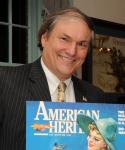Nearly 2,500 historians and authors have told the story of America in the pages of our magazine
-
Summer 2025
Volume70Issue3
You will find many treasures hidden in the American Heritage archives – more than 11,000 essays published over a span of 75 years. Nearly 2,500 writers contributed those stories that have literally become the memory of America.
“Over the years American Heritage has broken many stories of national importance,” recalled Richard Snow, my predecessor as Editor. “The purported pre-Columbian Vineland Map of North America, the case for Thomas Jefferson’s having fathered children with Sally Hemings (disclosed in 1972), the Duke of Windsor’s pro-Nazi views, and FDR’s secret Oval Office tape recordings all were revealed in our pages first.”
That's just the tip of the iceberg. (And, speaking of icebergs, the tragedy of the Titanic was largely forgotten after our nation endured the horror of some 8,800 ships sunk by U-boats in World Wars I and II – until 1955 when Walter Lord's essay “Maiden Voyage” revived memories of the tragic end of the “unsinkable” ship.)
In our pages, the famed suffragette Alice Paul recalled how she brought unrelenting pressure on the Wilson Administration that led to American women winning the right to vote in 1920.
Malcolm Cowley – a friend and editor of Ernest Hemingway, F. Scott Fitzgerald, Ezra Pound, and many others of the “Lost Generation” – later in life turned to writing about the love life of the Hawthornes in American Heritage, as well as one of the first serious histories of the slave trade.
Another member of the Lost Generation, famed novelist John Dos Passos, in the 1950s turned to writing history, including essays for American Heritage on Thomas Jefferson, the Marquis de Lafayette, Aaron Burr, and the genius who helped finance the Revolution, Robert Morris.
Secretary of State Dean Acheson helped define American Cold War strategy, and was instrumental in creating the Marshall Plan and NATO. Acheson later proved he had a sense of humor, writing in American Heritage about his experience in the horse-drawn field artillery in 1916, after Wilson “caught up with the realization that the United States had no army.” Taken out of Yale Law School, Acheson had to deal with "asthmatic horses... supplementing a more mundane daytime existence as brewery and dray horses.”
Barbara Tuchman, one of the most respected historians of the last century, published her first American Heritage essay, “Perdicaris Alive or Raisuli Dead,” in 1959. But the essay about Teddy Roosevelt's aggressive approach to a Moroccan warlord's kidnapping of an American family was so early in her career that Tuchman's brief author bio in the magazine described her as “the wife of a New York City physician.”
In 1966, a young editor in our book division, David McCullough, must have been thrilled when his first essay in American Heritage, “Hail, Liberty!” about the Statue of Library, was selected to be featured on the magazine's cover.
In the 21st Century, the historian John Eisenhower was one of the last men alive who had personally witnessed meetings of his father, General Eisenhower with Gen. George Patton and Winston Churchill. We were delighted to publish his memories in our pages.
Why does all this matter? American Heritage was founded five years after the end of World War II. That year the Soviet Union had just tested their first atomic bomb and the Cold War was heating up. There was a real need to define what made America different.
"What is needed in America today is a new appreciation and understanding of our American heritage and its advantages over the ways of totalitarianism and dictatorship," as one of the founders of the magazine wrote in its first issue.
“The use of history is to tell us what we are,” observed the famed jurist Learned Hand in American Heritage in 1953, “for at our birth we are nearly empty vessels and we become what our traditions pour into us.”

